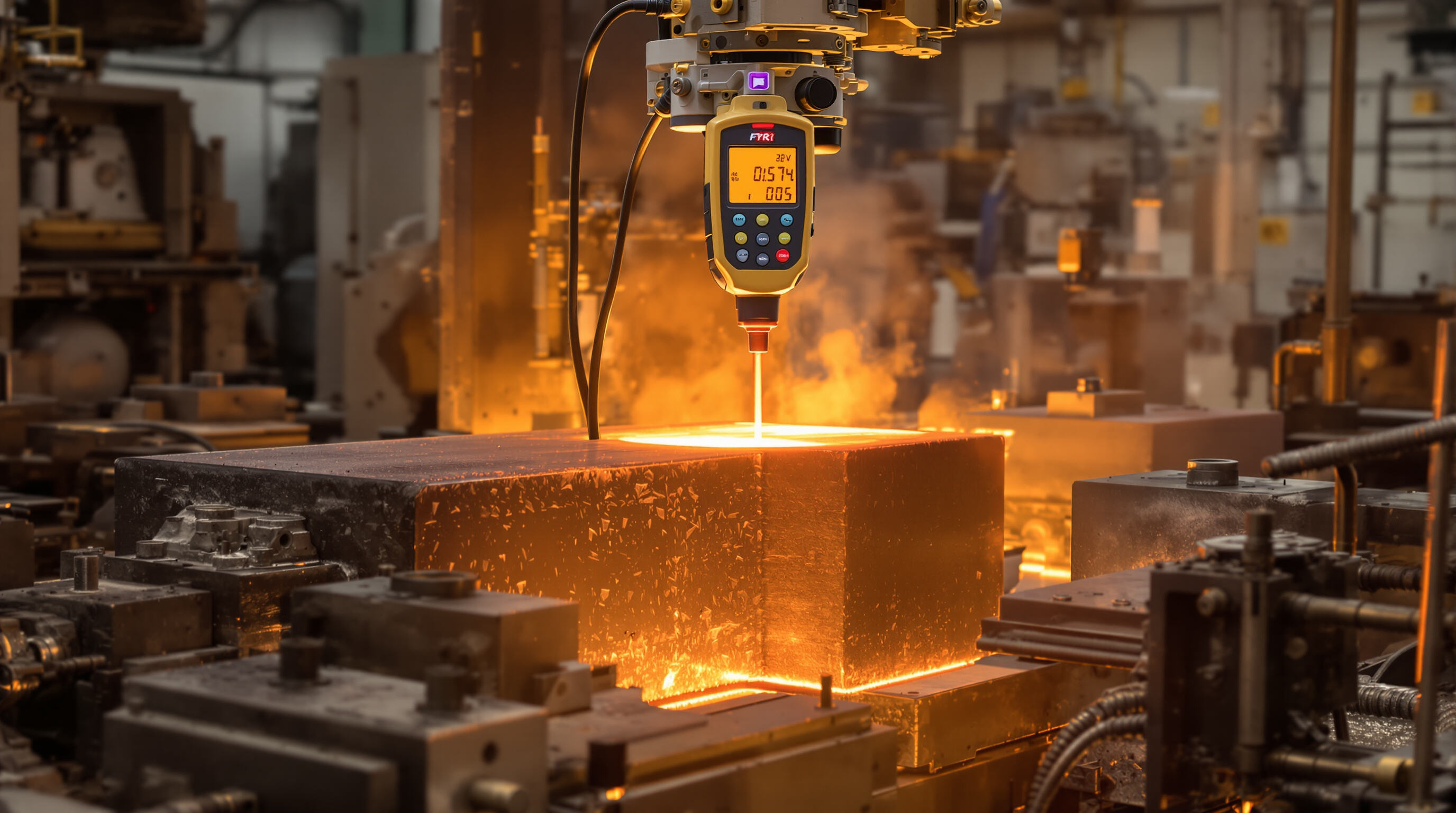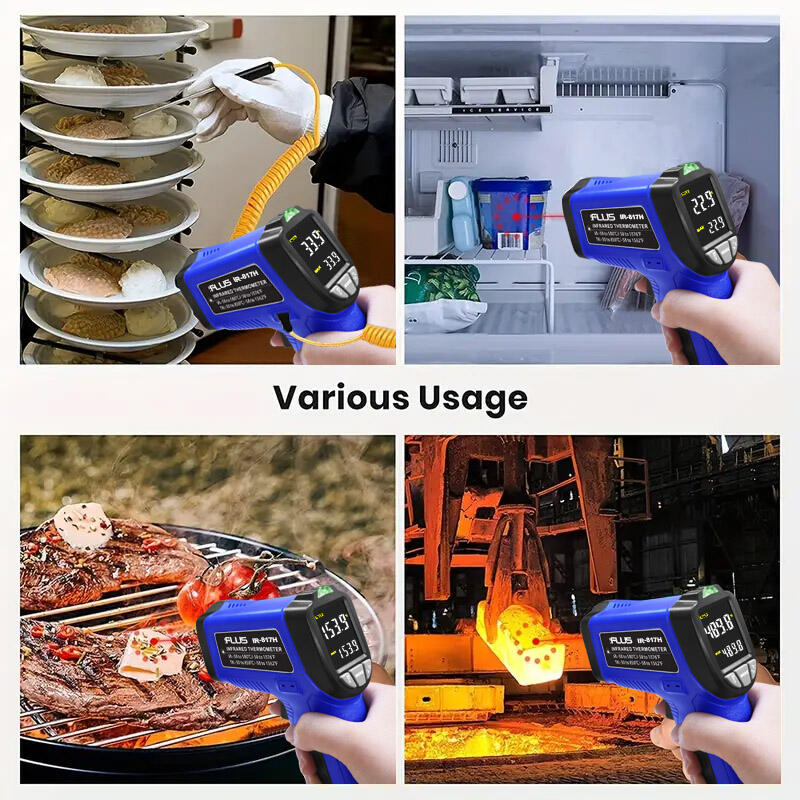Kuidas püromeetrid võimaldavad kontaktivaba temperatuuri mõõtmist tööstuslike rakenduste puhul
Vajadus kontaktivabade temperatuuriandurite järele keerukates keskkondades
Metallurgia ja klaasi tootmine esindavad kontaktandurite jaoks tõelisi väljakutseid. Kõrge temperatuur (mõnel juhul üle 1200 °C), liikuvad osad ja agressiivne keemiline keskkond muudavad kontaktandurid kõige paremal juhul ebausaldusväärseks. Püromeetrid pakuvad paremat lahendust, kuna need ei vaja otsese kontakti, võimaldades töötajatel jälgida tingimusi pidevalt, isegi rasku ligipääsetavates kohtades, näiteks kõrgahjus või voolava sulametalli lähedal. Hiljutine uuring mittetemperatuurimõõtmise sensoritehnoloogia valdkonnas näitas ka üllatavat tulemust: metallurgiatehased, mis kasutasid mittetemperatuurimõõtmisi, kogesid 63% vähem seadmetekahjustusi kui need, kes kasutasid traditsioonilisi termopaare. Väga keerulistes tingimustes vajavad tootjad tööriistu, mis suudavad vastu pidada koormusele ja samas anda täpseid mõõtmisi. Seetõttu on paljud tehased püromeetrite poole pöördunud mitte ainult ohutuskaalutlustel, vaid ka sellepärast, et need aitavad tootmisel vältida seiskumisi ja katkestusi.
Infrapuna püromeetrite tööpõhimõte tööstuskeskkonnas
Infrapunapüromeetrid töötavad objektidelt teatud lainepikkuste vahemikes, tavaliselt 0,7 kuni 20 mikromeetri vahel, kiirduva soojuskiirguse püüdmise teel. Neil seadmetel on optilised süsteemid, mis koguvad selle kiirguse ja saadavad selle seadmesse sisestatud termopilli või fotodetektori komponenti. Mis toimub järgnevalt? Need komponendid teisendavad kinnitatud kiirguse elektrisignaalideks, mis vastavad otseselt temperatuuri näitudele. Võtke alumiiniumi valtsimisvallid näiteks. Kui operaatorid seadistavad oma püromeetrid eriti 1,6 mikromeetri lainepikkusele, saavad nad palju paremad tulemused, kuna aur ja tolmakesed ei sega mõõtmisi nii palju. Miks see on oluline? Paljud tööstusmaterjalid peegeldavad valgust erinevalt sõltuvalt nende pindomadustest ja soojuse kiirgumisest. Erinevate lainepikkuste täpsele kesksemiseks saavad tootjad säilitada täpse temperatuuri jälgimise, hoolimata nendest väljakutsetest reaalse maailma tingimustes.
Peavõtmed täpsust mõjutavad: emissiivsus, lainepikkus ja keskkonnamõju
Kolm kriitilist muutujat määravad piromeetri tööd:
| Faktor | Täpsusele mõju | Riskide vähendamise strateegia |
|---|---|---|
| Emitants | Madal emissiivsus (nt õlitatud metallid) põhjustab alamääramist | Kasutage kahe lainepikkusega mudeleid |
| Lainepikkus | Vale valikul spektrivahemik nihutab mõõtmisi | Sobitage materjali omadustega |
| Keskkond | Tolm, gaasid või soojuslik taust moonutavad andmeid | Puhastusõhu süsteemid ja signaalifiltreerimine |
Näiteks kasutavad klaasitootjad mitmete lainepikkustega piromeetreid, et saavutada ±0,5% täpsus vedelklaasi temperatuuri kontrollimisel, arvestades läbipaistvust ja pindrefleksioone. Regulaarne kalibreerimine musta kehla kiirgusallide suhtes säilitab usaldusväärsust kõrgekütte rakendustes.
Püromeetri kasutamine metallide valmistamisel ja soojenduskeemidel

Temperatuuri probleemid terase ja alumiiniumi töötlemisel
Metallitöötlemise rakendustes, kus temperatuur ületab sageli 1500 kraadi Celsiuse, on püromeetrid eriti hea lahendus keeruliste mõõtmisprobleemide korral. Võtke näiteks terase kujundusoperatsioone või alumiiniumi ekstrudeerimisprotsessi – need tootmisjuhised nõuavad range temperatuuri kontrolli. Probleemiks on, et emissiooniväärtused muutuvad märgatavalt töötlemise käigus – sulametallidel on emissiooniväärtus tavaliselt vahemikus 0,3–0,7, samas kui tahketel materjalidel jääb see vahemikku 0,2–0,4. Selline erinevus tekitab tõelisi probleeme kontakti põhiste süsteemidega, mille mõõtmisviga võib ulatuda kuni plussmiinus 5 protsendini. Olukord muutub veelgi keerulisemaks, kui arvestada keskkonnaolusid, näiteks aurust, mis tekib jahutusvannide ajal, või loomulike oksüüdikihid, mis tekkivad kuumadel pindadel – kõik need segavad tavapäraste sensorite näiduaid viisidel, mis võivad taimsed operaatoreid ärritada, kui nad püüavad säilitada kvaliteedinõudeid.
Tegeliku aja jälgimine valmistamisel, kujundamisel ja rullimisel
Infrapuna-püromeetrid jälgivad temperatuure nendes kiiretes tööstusprotsessides, kus füüsilise mõõtesonda kasutamine lihtsalt ei sobiks. Võtke näiteks teraskehtluse. Kui tootjad saavad teha kohe mõned muudatused, kasutades neid spektrivahemike mõõtmisi, asemel, et oodata, kuni keegi iga nii kaua käsitsi kontrollib, siis näevad nad tegelikult umbes 28-protsendilist langust neis tüütutes teravate struktuuride probleemides. Ja alumiiniumi valtsimisvoolimis, jäävad need väikesed seadmed, mis töötavad umbes 1,6 mikroni juures, üsna täpsed pluss miinus 1%, isegi siis, kui kõik ümber nad väriseb kui hull masinast ja lennuvad metalli tolmukad kõikjal.
Püromeetrite integreerimine PLC-dega (programmeeritavate loogikakontrolleritega) sulkese protsessijuhtimiseks
Kaasaegsed seadmed ühendavad püromeetrid PLC-dega (programmeeritavate loogikakontrolleritega), et automatiseerida soojusjuhtimist. See integreerimine võimaldab:
| Parameeter | Parandamine võrreldes käsitsi juhtimisega |
|---|---|
| Vastamisaeg | 50 korda kiiremad kohandused |
| Energiatõhusus | 18% kütusekulu vähenemine põlemisel |
| Puuduse määr | 31% vähenenud kõverad osad |
2023. aasta uuring autotööstuse komponentide kujundamisest näitas, et suletud silmuse pirmeetrisüsteemid vähendasid soojusülejõudlust induktsioonküttekeeltega tagasilinki andes 35% võrra millisekundi tasemel.
Täpne temperatuuri juhtimine klaasi ja keraamika tootmisel
Kõrbklaasi temperatuuri mõõtmine spektrivahemiku optimeerimisel
Kui jutt on voolava klaasi temperatuuri mõõtmisest, siis püromeetrid on peaaegu kohustuslikud, kuna traditsioonilised kontaktandurid ei suuda sellega toime tulla kõrge temperatuuri (umbes 1600 kraadi Celsiuse järgi) ning materjali kleepuva iseloomu tõttu. Need seadmed töötavad kõige paremini, kui nad keskenduvad konkreetsele spektriosale, mis jääb vahemikku 3 kuni 5 mikronit, mis aitab neil eirata kogu seda tüütut infrapuna müra, mis tekib põlevate gaaside tõttu. Selline lähenemine tagab tootjatele umbes 1 protsendi täpsuse pikendatud klaasi tootmisliinidel. Hiljutised uuringud on näidanud ka midagi huvitavat – spektraalsete seadete reguleerimine parandab tõesti temperatuuri ühtsust täppis klaasimouldimisel. Tulemus? Umbes 40 protsenti vähem optilist moonutust kui see, mis tekib tavapärase laia spektritehnika kasutamisel, nagu näitas eelmisel aastal Shu ja tema kolleegide poolt avaldatud uuring.
Parandatud täpsusega mitmiklaine püromeetrid läbipaistvate materjalide puhul
Traditsioonilistel püromeetritel on raske toime tulemuseks emissiooni muutustega borosilikaadi ja sulandunud ränidioksiidi puhul. Mitmelaialiste mudelite puhul võrreldakse soojuskiirgust korraga 0,8 μm, 1,6 μm ja 2,2 μm puhul, kompenseerides automaatselt läbipaistvuse muutusi faasisiirdumise ajal. See lähenemine vähendab mõõtmisvigu 68% võrra ravimite klaasampullide tootmisel, kus keemilise stabiilsuse tagamiseks on vajalik ±2°C stabiilsus.
Põlemistemperatuuri jälgimine keraamiliste põlemisahjude töös
Kaasaegsed püromeetrimassiivid jälgivad soojusgradiendi 20 meetri pikkustes tööstusahjutes, tuvastades külmetpunkte, mis põhjustavad keraamika kõverdamist. Plaaditootmisel võib reaalajas jälgimine 5 sekundi intervallides ennetada vitrifikatsiooni vigu, säilitades maksimaalse temperatuuri 1250°C piires, millel on ±5°C tolerantsivööndid.
Kalibreerimise ja joondamise strateegiad usaldusväärsete näidu saamiseks kõrge kütte keskkonnas
Kvartaline kalibreerimine mustvalge kehade vastu tagab püromeetri täpsuse, isegi kui objektiiv on saastunud. Insenerid kasutavad 30° nihkelaserite ja puhastusõhusüsteemide kombinatsiooni optilise selguse hoidmiseks, saades 99,3% tööaega klaasi float-joontel. Reguleeritavad emissiooni seaded (vahemikus 0,20–0,95) võimaldavad hõlpsat kasutamist erinevate materjalidega, alustades läbipaistvatest keraamikatest kuni pool läbipaistvate ränidioksiidigeelideni.
Püromeetrid kõrgkiiruse ja raske tööstuse valmistusprotsessides
Echtidsed jälgimine rulli- katta- ja kunstainete tootmisel
Püromeetrid on eriti head olukordades, kus temperatuuril peab kiiresti muutuma, mõelge näiteks rull-roll-kihitud või kui plastik ekstrudeeritakse väga kõrgel kiirusel. Polümeeridega töötamisel võivad need infrapunased sensorid jälgida sulamistemperatuuri täpselt nendes olulistes punktides mõõtes täpsusega plussmiinus 1%. See võimaldab operaatoreil reguleerida materjalide jahtumise kiirust enne kui need kõverduvad või tekivad soovimatud kristallstruktuurid. Ja rääkides kiirusest, metalli katoodkatte tootmisel hoiavad need seadmed silma peal alusmaterjali temperatuuril, kui asi liigub edasi üle 300 meetri minutis. See on palju kiirem kui vanad tõuskevad termopaarid, mis olid tavaliselt vastusaja poolest ühest kuni kahte sekundit.
Toimivusplussid tolmases, vibreerivas ja korrosiooni tekitavas keskkonnas
Puudutusvabad püromeetrid ületavad kolm olulist tööstuslikku väljakutset:
- Tolmuvastupidavus : IP67-hinnanguga mudelid säilitavad täpsust tsemenditehastes, kus partiklite tase on 20 mg/m³
- Vibratsioonivastupidavus : Kõvakõhjalised konstruktsioonid töötavad usaldusväärselt kovamisse pressides, mis ületavad 12 G-kiirendust
- Korrosiooniimmuunsus : Safiirsoptika vastab happelisele atmosfäärile elektrolüütimisel
2023. aasta välisuurve näitas, et ranglikes keskkondades tuli kontaktanduritega võrreldes 93% vähem kalibreerimisvahendeid.
Traadita pirometri võrgustikud tööstusele 4.0 ja ennustava hoolduse jaoks
Tootajad pöörduvad üha enam aku töötavate püromeetrite poole, millel on LoRaWAN ühenduvus, et paigaldada suurtel tööstusplatsidel täielikud temperatuuri jälgimise süsteemid. Neist võrgustikust kogutud andmed sisestatakse ennustavatesse mudelesse, mis suudavad ennustada, millal alustavad tulekindlad materjalid sulandusprotsesside ajal lagunemist, mõnikord kuni kolm nädalat ette. Võtame näiteks ühe autotöotmisfirma Saksamaal, kus traadita temperatuurisensorite rakendamine vähendas soojusest tingitud tootmispeatuseid peaaegu kahe kolmandiku võrra. Ka hoolduskulud langesid märgatavalt, säästes aastas ligikaudu 740 000 dollarit nende aruannete kohaselt.
Miks valida püromeetrit kontaktandurite asemel? Võrdlevad eelised ja ROI
Termodioodide piirangud liikuvates või agressiivsetes keskkondades
Kontaktsensorid nagu termopaarid silmitsavad raskeid väljakutset tööstuskeskkondades. Kõrge kiirusega valtsimisjuhtmetes või korrosiooni tekitavates keemilistes protsessides kiirendab pindadega kokkupuude sensori lagunemist, suurendades kalibreerimise kõrvalekallet aastas 15–20%. Termopaaridel tekib ka probleeme:
- Mõõtmise viivitus (3–8 sekundit) kiirete tootmisliinide puhul
- Ohutusriskid kui jälgitakse sulametalle või plahvatusohtlikke atmosfääre
- Sagedased vahetused mehaanilise kulumise tõttu, mille tõttu kulutavad tehased aastas keskmiselt 18 000 USD hooldusel
Pikaajaline stabiilsus, ohutus ja seismise vähendamine pirmeetritega
Kaasaegsed infrapunapirmeetrid kõrvaldavad need probleemid kontaktivaba toimimise kaudu. Väljaantud soojuskiirguse mõõtmise teel säilitavad nad ±0,5% täpsust rohkem kui 5 aasta jooksul terasetehastes ja klaasipõletusahjudes. Olulisemad eelised on:
- Null mehaanilist kulumist vibratsiooni või kriimustamise tõttu
- Reaalajas näidud (0,1-sekundiline reaktsiooniaeg) sulkuringi temperatuuri juhtimiseks
- 40% vähem planeerimata seismisaega temperatuuri järelevalve abil kättelülitites
Kokkulepitud omanduskulu: Püromeetri investeeringu põhjendamine tööstuskeskkonnas
Kuigi püromeetritel on kõrgem algkulu kui kontaktanduritel ($2000–$8000 vs $300–$1500), on nende ROI ilmne 12–18 kuuga:
| Kulutegur | Termopaarid | Püromeetrid |
|---|---|---|
| Aastane hooldus | $12 000–$20 000 | $1000–$3000 |
| Kalibreerimise sagedus | Igakuine | Kahekordne |
| Protsessi kasvu parandamine | 0–2% | 5–9% |
Taimsed püromeetrite kasutamisel on alumiiniumprofiilide ekstrudeerimisel kvaliteedikindlaksmärkide arv väiksem 23% ja keraamikapõletusahjude energiasäästuks 17% tänu täpsele temperatuuri reguleerimisele.
Sageli küsitud küsimused
Mis on püromeeter?
Püromeeter on seade kõrge temperatuuri mõõtmiseks ilma otsese füüsilise kontaktita mõõdetava objektiga.
Miks eelistatakse püromeetreid tööstuskeskkonnas kontaktandureid?
Püromeetrid võimaldavad pidevat mittekantaktset temperatuuri mõõtmist, mistõttu on need usaldusväärsemad ja vastupidavamad kui kontaktandurid äärmistes tingimustes.
Kuidas püromeetrid mõõdavad temperatuuri?
Püromeetrid mõõdavad temperatuuri, tuvastades objekti poolt kiiratud infrapunakiirgust ja teisendades selle elektriliseks signaaliks, mis kajastab temperatuuri.
Millised tegurid mõjutavad püromeetrite täpsust?
Püromeetrite täpsust võivad mõjutada emissioonivõime, lainepikkuse valik ja keskkonna häired, näiteks tolm ja gaasid.
Kui sageli tuleb püromeetreid kalibreerida?
Püromeetrid vajavad tavaliselt iga kahe aasta tagant kalibreerimist, kui võrrelda kuu aega vajavate kontaktanduritega, nagu termopaarid.
Sisukord
- Kuidas püromeetrid võimaldavad kontaktivaba temperatuuri mõõtmist tööstuslike rakenduste puhul
- Püromeetri kasutamine metallide valmistamisel ja soojenduskeemidel
- Täpne temperatuuri juhtimine klaasi ja keraamika tootmisel
- Püromeetrid kõrgkiiruse ja raske tööstuse valmistusprotsessides
- Miks valida püromeetrit kontaktandurite asemel? Võrdlevad eelised ja ROI
- Sageli küsitud küsimused

